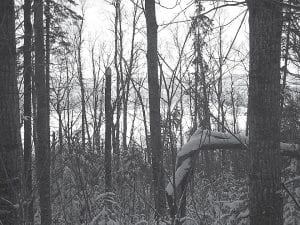The county board decided on September 22, 2009 to make a statement to the U.S. Forest Service regarding the potential impact of the sound of snowmobiles on the Boundary Waters Canoe Area Wilderness (BWCAW).
A lawsuit filed in 2006 has resulted in a federal Court of Appeals directive to the U.S. Forest Service to prepare an Environmental Impact Statement (EIS) assessing the potential impact to the BWCAW of sound coming from several proposed reroutes of a snowmobile trail near South Fowl Lake. The first step of an EIS is “scoping,” during which the public is invited to present new information.
In a letter written to Gunflint District Ranger Dennis Neitzke on behalf of the county board, Commissioner Bob Fenwick stated, “…We are disappointed that the Forest Service did not appeal the specific ruling to undertake this new and redundant environmental study.”
The letter drafted by Commissioner Fenwick supports the Forest Service’s selection of the second of several alternative trail routes: “By selecting Alternative 2 as a replacement for a snowmobile route that was displaced by the establishment of the BWCA Wilderness, the Forest Service dutifully fulfilled its legal obligation under the BWCA Act of 1978, that being to ‘expedite and intensify’ such activity outside the wilderness area. The exhaustive studies completed prior to this decision, including an Environmental Assessment, did indeed result in the establishment of a ‘safe, legal snowmobile access from the McFarland Lake area to South Fowl Lake.’
“We feel it necessary to state that no action should ever be taken to create either legally or by custom a buffer zone of any kind near the boundaries of the Wilderness. Along with the deleterious economic and cultural effects, it should be noted that such zones stand in direct conflict to the intent of the BWCA Act of 1978. … We believe that there are suitable statewide rules governing snowmobile noise that could be easily applied.”
Section 18A of the BWCA Act of 1978 states: The
Secretary is authorized and
directed to expedite and intensify
the program of dispersed
outdoor recreation development
on the Superior National
Forest outside the Boundary
Waters Canoe Area Wilderness,
as designated by this Act. The
Secretary shall consider in such
new program development the
need for the following: additional
snowmobile trails, particularly
those now planned
or under construction; remote
campsites on lightly developed
lakes; and lake access sites and
parking facilities to provide
motorized recreation experiences
similar to those previously
available in the Boundary
Waters Canoe Area.
The fall 2009 Northeastern Minnesotans for Wilderness (NMW) newsletter states a very different perspective from the county board: “This is the latest move in the FS controversial six-year attempt to build a trail just outside the eastern edge of the Boundary Waters Canoe Area Wilderness (BWCAW) that few will use and no one needs. Theproject, already an expensive boondoggle, will continue to drain scarce dollars and personnel down this trail to nowhere.” The article states NMW’s belief that Alternative 2 would most adversely impact the BWCAW. “FS should not be allowed to impact the wilderness character so that a few can shortcut to their favorite fishing spot,” the newsletter states.
The county board gave its approval for the letter drafted by Bob Fenwick to be sent to Dennis Neitzke on behalf of all five commissioners.



Loading Comments